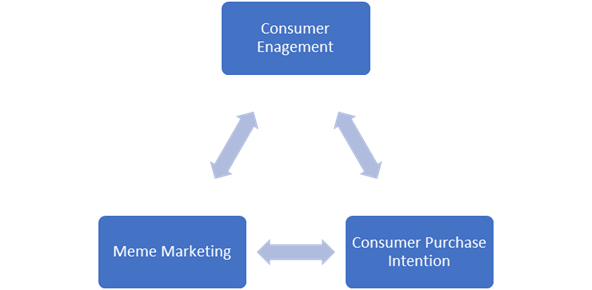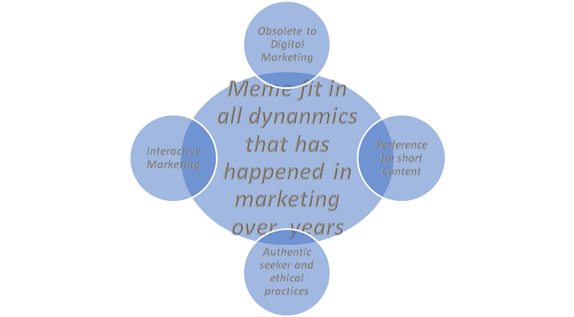In today’s world, no one is interested in seeing ads or marketing; people prefer to pay for a subscription to remove this content from their feeds. So, in a world where people spend most of their time watching screens, it is very difficult to promote through digital campaigns, as they can sense these marketing tactics from a distance. So, we have come up with a way that people enjoy when they watch marketing content. So here comes the picture

Meme marketing means using humorous or sarcastic text, images, or videos to promote your brand. The meme was first introduced by Richard Dawkins in his book “The Selfish Gene.” A meme has three components: content, form, and stance. A brand can use user-generated memes or make memes to increase customer engagement. For example, Netflix generates memes based on its series. Like, I can’t be the only one on Instagram to promote its series “Squid Game 3.”
In this meme, “content” means the idea is to relate with the audience when they are the only one in their friend group who have watched the show, and “form” means a physical or visual representation of the idea in a meme, like a Netflix show. The form is shown through one of its characters from that series with a frustrated emotion on its face and stance, which means a tone used in memes, like the humorous tone used in the example above.
Meme and Customer Engagement
Memes contain human emotions in text or images, which people feel as a sense of connectivity. A meme can contain different types of emotions, like humour or sadness. If a person can relate to a meme, then it will increase customer engagement. Humorous memes tend to be more interactive than serious ones because they encourage people to share them with friends and family, ultimately increasing the success rate of the marketing campaign.

Gen Z and the Dynamics of Marketing
As 24.6% of the global population comprises Gen Z, which is 2 billion people, in 2024, according to Statista.com, to be relevant in marketing, whether it is in the health or fashion sector, we need to understand today’s generation dynamics to have a perfect market strategy.
Dynamics of Marketing
- Obsolete to Digital Marketing: As most Gen Z are born in the era of the internet, old practices of television commercials, billboards, cold calling, etc., are less effective as Gen Z are ad-averse. According to the Pew Research Centre (2024), 95% of Gen Z own a smartphone, so it is useless to focus on traditional methods of marketing.
- Preference for short content: Gen Z has a short attention span, so they watch more short video content than long content. So, meme marketing is the most effective tool to target Gen Z.
- Preference for business ESG practices: According to the Deloitte (2024) report, 70% of Gen Z customers are willing to pay for a sustainable product, so we need to keep that in mind. Any marketing content, whether a humorous meme or brand face, should not promote any unethical practices.
- Interactive marketing practices: Gen Z prefers personalized brand interaction where they can feel connected to that brand. As there is a plethora of information available, to reach your target, you need to be more unique and connected to the audience.

Some Statistical Facts about the Meme Industry
- According to Forbes, meme marketing have ten times more engagement than a standard marketing campaign.
- As stated by Enterprises App today, meme marketing have a 14% higher click-through rate than email marketing.
- As reported by Statista, social media users will rise to 6 billion by 2027.
Conclusion
Meme marketing will be a core part of digital marketing, as we are living in an era where people get easily distracted, as there is a lot of content available, so to be relevant, we need to make personalised content and be more interactive with our customers. Memes are the best fit in today’s dynamic environment, as memes are not just a joke that people are sharing, but a strong engagement tool to be close to your customer.
FAQs About Meme Marketing
1. What is Meme Marketing and Why Is It Gaining Popularity?
Answer:
Meme marketing refers to using humorous, relatable content—like images, videos, or GIFs—to engage audiences and promote brands. It’s gaining popularity because it taps into the online culture of humor and rapid content sharing. Unlike traditional ads, meme marketing feels more organic and less intrusive, especially to Gen Z and millennials who value authenticity.
2. How Does Meme Marketing Work in Brand Promotion?
Answer:
Meme marketing works by combining pop culture with a brand’s message. Brands either create original memes or use trending formats tailored to their audience. When done right, memes go viral, leading to massive engagement, high visibility, and a boost in brand recognition—without spending heavily on traditional advertising.
3. Why Is Meme Marketing So Effective With Gen Z?
Answer:
Gen Z is digital-native and deeply involved in meme culture. They dislike pushy ads but respond to authenticity, humor, and relatability. Meme marketing allows brands to enter their digital space with content that resonates. It breaks down barriers and creates a connection that standard advertising can’t.
4. Can Meme Marketing Help Small Businesses Compete With Big Brands?
Answer:
Absolutely. Meme marketing is cost-effective and accessible. Small businesses can use free meme generators or apps like Canva to craft impactful content. The humor and shareability of memes can quickly level the playing field by giving smaller brands exposure that rivals paid ad campaigns.
5. What Are the Key Ingredients of a Good Meme Marketing Campaign?
Answer:
A successful meme marketing campaign hinges on understanding your audience, using relevant humor, and aligning with current trends. Timing is critical—posting while a meme is still popular ensures maximum impact. Also, the tone must match the brand identity, whether it’s playful, sarcastic, or informative.
6. How Do You Measure the Success of Meme Marketing?
Answer:
Key performance indicators (KPIs) for meme marketing include engagement rates (likes, shares, comments), reach, click-through rates, and conversions. UTM parameters help track traffic from memes. Analyzing sentiment and user interaction also provides insights into how well your meme resonated with the audience.
7. What Platforms Are Best for Meme Marketing?
Answer:
Instagram, Twitter (X), and Facebook are excellent platforms due to their visual nature. TikTok is especially popular for short-form video memes. LinkedIn can be used with professional humor for B2B meme marketing. The platform choice should align with where your target demographic spends their time.
8. Are There Risks Associated With Meme Marketing?
Answer:
Yes, meme marketing can backfire if not done thoughtfully. Using outdated, offensive, or irrelevant memes can alienate audiences or damage brand reputation. It’s crucial to stay culturally aware and sensitive. Avoid jumping on controversial trends unless they align with your brand’s values.
9. How Can Brands Ensure Cultural Sensitivity in Meme Marketing?
Answer:
Brands should have diverse teams review content to avoid tone-deaf or insensitive memes. Staying informed about social issues and trending topics helps avoid missteps. Meme marketing should aim for inclusivity and respect, ensuring humor doesn’t come at the expense of marginalized groups.
10. Can Serious Industries Use Meme Marketing Effectively?
Answer:
Yes, even sectors like healthcare, finance, and education are using meme marketing to make complex or dry topics more engaging. For instance, banks can use memes to explain interest rates humorously, while healthcare companies may share funny wellness tips to encourage healthier habits.
11. How Does Meme Marketing Improve Customer Engagement?
Answer:
Meme marketing invites users to react, comment, and share—boosting interaction naturally. Unlike static ads, memes feel like part of the user’s content feed rather than a disruption. The humor and relatability encourage deeper engagement and strengthen brand recall.
12. How Can You Use Memes Without Violating Copyright?
Answer:
To stay on the safe side, use royalty-free images, original content, or meme templates from public domains. Avoid altering copyrighted material or using celebrity images without permission. Platforms like Imgflip offer editable, legally safe templates for meme marketing use.
13. What Makes Meme Marketing Go Viral?
Answer:
A viral meme usually has three things: timeliness, relatability, and humor. It often taps into trending pop culture, social issues, or current events. When users find it funny and relevant, they share it, causing exponential reach—a cornerstone of successful meme marketing.
14. How Frequently Should Brands Post Meme Content?
Answer:
Consistency matters, but overposting can make your brand seem desperate or spammy. A balanced meme marketing strategy might include 2–4 memes per week. Focus on quality and relevance rather than quantity. Monitor performance to refine your posting frequency over time.
15. Can User-Generated Memes Boost a Brand’s Visibility?
Answer:
Yes, encouraging fans to create and share their own memes builds community and increases reach. It shows real engagement and builds brand credibility. Meme marketing thrives on participation, and user-generated content turns your audience into promoters.
16. How Does Meme Marketing Differ from Influencer Marketing?
Answer:
Influencer marketing relies on personal endorsements from well-known individuals, while meme marketing spreads messages through humor and relatability. Meme content is more organic and less tied to individuals, often having a broader and more viral reach than a single influencer’s post.
17. What Role Does Timing Play in Meme Marketing?
Answer:
Timing is critical. A meme loses relevance quickly. Effective meme marketing capitalizes on trends as they emerge. Posting too late can make your brand appear out-of-touch. Staying plugged into trending hashtags and internet culture is essential for timing your memes right.
18. Can Memes Influence Purchasing Decisions?
Answer:
Yes, memes subtly influence purchasing by embedding a product or idea within a funny or relatable scenario. When a user laughs at a meme about your product, they form a positive association. Over time, this emotional connection fosters trust and increases the likelihood of conversion.
19. How Do You Keep Meme Marketing Fresh and Relevant?
Answer:
Stay active on social platforms, follow trending hashtags, and subscribe to pop culture feeds. Rotate formats—try image memes, video memes, and carousel memes. Collaborate with content creators or tap into niche communities to refresh your meme marketing strategy regularly.
20. What’s the Long-Term Future of Meme Marketing?
Answer:
Meme marketing is evolving alongside technology. With AI, personalization, and predictive algorithms, future memes could be hyper-targeted. As humor remains universal, memes will continue to dominate the digital space. Brands that embrace this evolution early will stay ahead in the attention economy.
References
- https://www.researchgate.net/profile/Navrang-Rathi/publication/377116237_Impact_of_meme_marketing_on_consumer_purchase_intention_Examining_the_mediating_role_of_consumer_engagement
- https://journals.sagepub.com/doi/full/10.1177/10949968251320612
- https://www.researchgate.net/profile/Sphurti-Sewak/publication/391522289_Brand_posts_with_memes_on_social_media_perceived_humor_and_consumer_engagement/links/681b7580bd3f1930dd6d878f/Brand-posts-with-memes-on-social-media-perceived-humor-and-consumer-engagement.pdf
- https://www.forbes.com/sites/forbescommunicationscouncil/2018/08/10/memes-a-digital-marketing-tool-for-every-industry/
- https://www.enterpriseappstoday.com/stats/memes-statistics.html#What_are_Memes
- https://www.statista.com/statistics/270919/worldwide-social-network-user-growth/
- https://www.pewresearch.org/internet/2024/12/12/teens-social-media-and-technology-2024/#:~:text=to%2070%25%20today.-,By%20age,gaming%20console%20or%20tablet%20computer
Penned by Manshika
Edited by Sneha Seth, Research Analyst
For any feedback mail us at [email protected]
Transform Your Brand's Engagement with India's Youth
Drive massive brand engagement with 10 million+ college students across 3,000+ premier institutions, both online and offline. EvePaper is India’s leading youth marketing consultancy, connecting brands with the next generation of consumers through innovative, engagement-driven campaigns. Know More.
Mail us at [email protected]

Creating contacts and utilising those acquaintances is an important part of moving up the ladder of success. Networking can be seen in many formats like handing out your business card in a social event, connecting a company’s internal network to the Internet or any other form in which people/ social groups are connected.
The purpose of networking is to make new friends, industry acquaintances, and even business partners, which help you make progress on your career path quickly. Expanding your contacts can open doors to new opportunities for business, career advancement, and personal growth. Having several connections with professional people will help you when you need an opportunity or want to clear your doubts.
Networking doesn’t mean going up to strangers and asking for their number or going out partying, but building fruitful connections can be a professional and gradual process. Meeting people through mutual friends, networking events, a workplace can be an easy way to start building your network. Meeting people who are going through similar experiences or have overcome obstacles you may be facing is always a great learning opportunity to make you a better individual.
Volunteering your skills for your acquaintance builds trust between your networks. Every event no matter how minuscule can help you grow your networks and in turn, help you in the long run.
Penned by Names
Edited by Ritika Sharma, Research Analyst
For any feedback mail us at [email protected]
Transform Your Brand's Engagement with India's Youth
Drive massive brand engagement with 10 million+ college students across 3,000+ premier institutions, both online and offline. EvePaper is India’s leading youth marketing consultancy, connecting brands with the next generation of consumers through innovative, engagement-driven campaigns. Know More.
Mail us at [email protected]